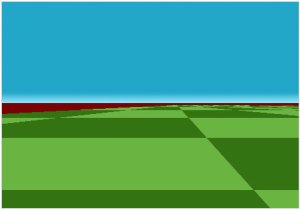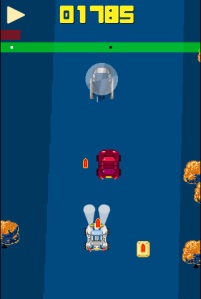I’ve written it before that I’m not a huge fan of design documents for small projects. I’d rather be coding. So please don’t consider this as a literal document it’s more my own thoughts on some pointers for creating cool arcade games. I guess it goes hand in hand with my previous thoughts on the importance of arcade game design.
Know your character
Create your game character / spaceship / thing and set up some basic controls. Play it. Use it. Get to know it.
Is it fun to watch and control ?
What situations would it be cool to have to deal with with your on-screen character.
Start to consider the look and style of a potential adversary for your character.
If you character can jump what kind of obstacles and challenges might he face ?
For many people just getting something on to the screen is an achievement – often the result of an initial technology test. It’s an exciting time. When you bind it to input it becomes even more thrilling.
I remember walking the Wizard in Wizard Wars around a blank screen for hours before it came to me that he should be collecting things.
Initially I had wanted to stage a battle between the Wizard and a number of mythical beasts. One in which my goal was to battle through waves of beasts using bolts of magic lightning and other such fantastical things. I guess in my mind it was Robotron with magic.
But I was controlling the little guy on a touch screen (first gen iPod Touch) and really didn’t feel comfortable with littering the screen with magic. Especially as the Wizard could move freely in 8 directions and wasn’t just restricted to his own area of the screen. It could have started to look very messy and confusing for the player.
I liked the idea of the Wizard tidying up his room. To me that was his role and formed his identity. Perhaps he was less the all battling Warlock and more the bumbling Merlin-esque Wizard who just happened to have magic.
Back to the controls.
Hurling the birds in Angry Birds is a lot of fun. It could easily be a device for another game. e.g. aim for the furthest distance.
Running the corridors in DOOM and just pulling the trigger is a lot of fun. As is flying over the planet surface in Defender just blasting lasers left and right.
There are so many games where just interacting with your character / vehicle is tremendous fun regardless of the actual goal of the game.
For me this is very much the first thing to get right in your game. If the one thing that you spend your entire game experience doing is poor or less than stimulating or heaven forbid confusing then your game will die.
My wife I’m sure despairs at the sight of me running a simple animated sprite around an empty screen whilst making all manner of noises and talking to myself. But for me it is a hugely creative experience.
Define the broad goal
Games need goals. Something for the player to aim for.
I’m a big fan of layering content in games. That is, you keep in mind the broader goal but the path to it is paved with smaller ones.
In DOOM your goal is clear. You find the exit and start over in a new level.
Same goes for Angry Birds. You wipe out the pigs and move on. The fact that death and destruction lie between you and your goal is merely an enjoyable consequence.
Your broad goal should be explained and where possible available to the player at all times as a visual reminder. I am of course thinking of PacMan. Games where everything is on the screen at once really allow you to achieve this. Multi-screen games are more of a challenge.
With hindsight I would probably have altered Wizard Wars to have the star count decrease to zero rather than simply incrementing the figure in the top corner of the screen. The reason is simple, not everyone reads the instructions. If you just drop in to the game it’s not at all obvious that you are aiming to collect 50 stars. Far better to count down since the player will quickly identify the goal as being zero.
In HyperGunner I dangled the carrot of “miles to Earth” at the end of every level.
This quickly forms the broad goal of the game and is mentioned in the pre-game screen.
Working back from there I was able to provide suitable sub-goals that moved the player through the game logically. i.e. collect stars to build up the hyperspace power bar.
Once in hyperspace the player is hurled that bit closer to Earth – the ultimate goal of the game.
Again with hindsight I would probably have staged the game a bit better. As it is the stars, diamonds and score multipliers are all generated randomly. Perhaps it would have been better to have spawned the hyperspace stars in line with an alien bomb or a saucer missile to add an extra challenge to the player.
These things invariably come to you once you’ve played your game to death.
Know your enemy
Your enemy is vital to your game. Games without challenges are dull. Games without conflict are dull. Of course you can define conflict in the true sense as being a shoot out or a physical struggle or you can express conflict as more of a struggle against time or resources. Either way the concept of conflict is key.
Your game needs to constantly throw stuff at you and you as the player must control the game such that you overcome all of it.
Your enemy should provide all of this.
Whether you define the enemy as an array of aliens, a wall of bricks or a ticking clock they should all seek to get the better of you by taking your goals and doing their utmost to prevent you from achieving them.
The better arcade games offered variety in the design of the enemy.
PacMan (again) with its varying ghost AI. Defender with its Baiters, Mutants and Saucers.
More recently DOOM with its mix of monsters and of course Angry Birds with its varying HP amongst the pigs.
Design is everything here.
If you have an enemy that hurls a visible bolt of magic at the player where is the best place to position it ?
If you have an enemy that seeks to crush the player where might you place it for maximum effect ?
If you have a goal that is set against a ticking clock in say a driving game what kind of enemy might you place in front of the player ?
It’s all about countering the interests of the player and his ultimate goal.
When you are designing your game on paper try to write down the role and actions of the enemy before you draw what it might look like.
The curve
In drama there is a simple rule that your protagonist must become something through his actions.
The simplest example I could find is the young farm boy Luke Skywalker in Star Wars who dreams of flying starfighters and taking on the Empire. Of course not only did he do that but he also had very close links to the Empire. Luke’s character curve (or arc) was quite pronounced and extremely satisfying for the viewer to consume.
In games we should strive to achieve the same thing. Whether we control a physical avatar or simply manipulate the contents of the screen we should ultimately feel like we have come from humble origins and through our actions – and hence increasing skill – have become something quite special such that we can take on anything that the game can hurl at us.
The game therefore, for its part, should naturally hurl everything it can at us by this stage.
A player needs to be tested at all times and then rewarded.
The “curve” that the player experiences can then be measured by their accumulation of rewards.
In modern FPS games you see this done with bigger weapons, greater ammo capacity and tougher adversaries. Well, bigger adversaries with higher HP. FPS games are frequently dull since they fail to move beyond this dynamic for progressing the protagonist through his curve.
In shoot ’em ups, another fine example of the character curve in action, you cannot get away with simply throwing bigger, faster and more deadly aliens at the player without first preparing the player with such things as shields, laser improvements and smart bombs.
More often than not your character curve is identifiable through the staging of your game’s content in the later stages. By virtue of the fact that your character is sat amongst complex enemy AI with all manner of obstacles in his path is evidence that the player has taken that journey and accumulated all the rewards en route.
So when you’re designing your game consider a snapshot of how you imagine your game or character / screen to look in the final shot (if of course your game ever ends !) and overlay that with the very first view of the game that the player saw.
If the two images look similar you may want to re-think some of the obstacles and goals.
Hopefully these thoughts will help you to lay the foundations of your game.
Designing games is a huge amount of fun. Coming up with the various levels, obstacles and game “personalities” is what makes it such a thrilling exercise.
Realising that your game is dull and devoid of challenges at a late stage in its development is no fun at all and extremely frustrating.
I believe that anybody can design a fun game. It’s not the preserve of large corporate entities and 5 minute wonder studios.




